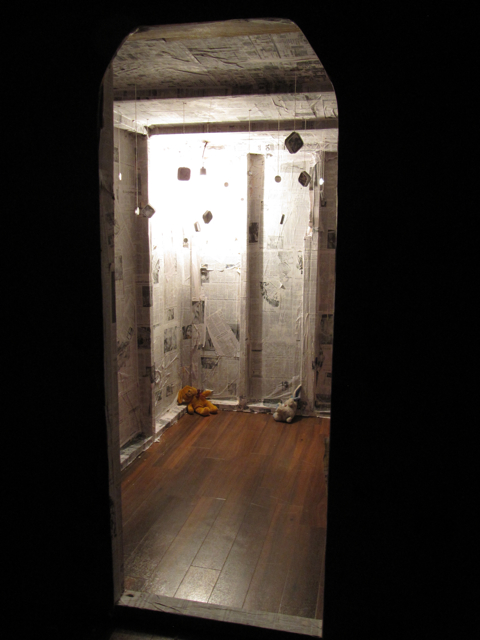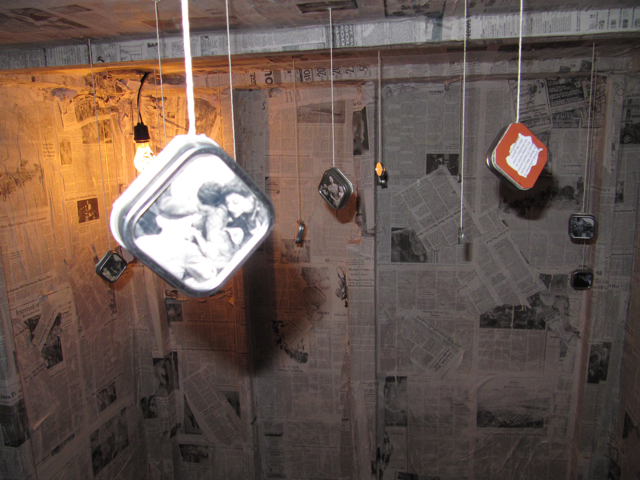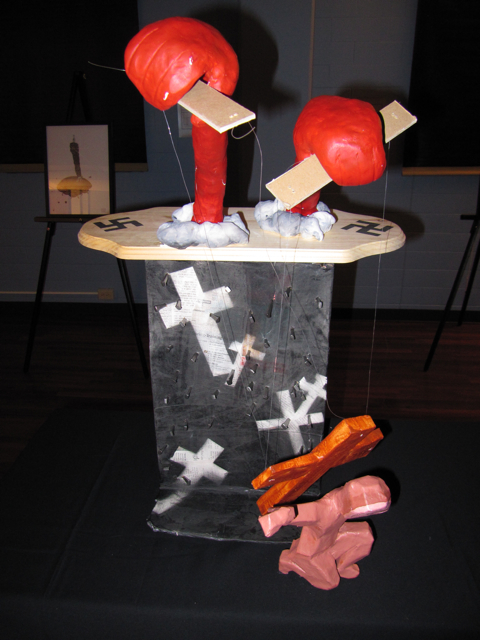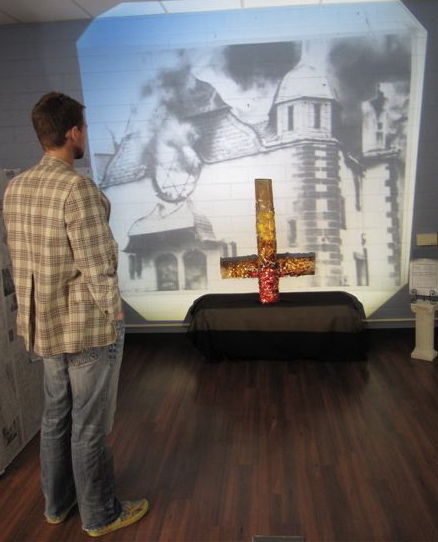
Father, Forgive Us (part 1)

Easter week was always a dangerous time for Jews in Europe. Since Christians believed the Jewish people were responsible for killing Jesus, all the focus upon his passion and crucifixion often resulted in violence being perpetrated against Jews. By the late Middle Ages Jews had learned to stay indoors during Holy Week. This Easter season I’ve been working through how to practice my Christian faith in light of the church’s heritage of anti-Semitism. And it’s why I’m at Baylor University this week.
The Center for Jewish Studies at Baylor brought me here to install an art exhibit I’ve designed with six other artists. The exhibit – entitled “Father Forgive Us” – deals with the Stations of the Cross in a post-Holocaust world. On Tuesday I gave a lecture explaining its theological underpinnings, and yesterday and today it is open to the public.
All this really began back in the spring of 2004. I was in my last semester at Baylor and enrolled in the course “Hitler and the Holocaust” taught by the Jewish theologian Dr. Marc Ellis. Through his lectures and the readings for the course, I first faced the reality that my Christian faith does not exempt me from what was done to 6 million Jews in the Holocaust. In fact, it is precisely my Christian faith that links me with these atrocities. I’ll return to that in a moment.

[Station 1, “Jesus is condemned to death / Adolf Hitler becomes Chancellor.” Artists: Nela Emmanuel and Will Roberts]
I’ve developed a unique friendship with Dr. Ellis over the last few years (he refers to me as his “evangelical preacher friend”), and last spring he asked if I would be interested in designing this exhibit. I wasn’t sure I wanted to revisit the horrors of the Holocaust, but I accepted. I knew the project would be difficult, but important.
Let me share a brief history of the Stations of the Cross and then of the church’s heritage of anti-Semitism since the art we’ve created came out of a collision between these two.
History of the Stations of the Cross
The Stations of the Cross dates back to early Christians who visited Jerusalem in order to literally follow the way Jesus went to the cross. During Holy Week these pilgrims would retrace and reenact the last events of Jesus’ life.
A fourth century woman named Egeria traveled to the Holy Land between the years 381 and 384 and kept a written account of her journey, now titled Egeria’s Travels. Beginning early on Good Friday morning and lasting well into the night, pilgrims gathered at various sites near the place of Jesus’ death for scripture readings and prayer.
Around the fifth century, this was being practiced outside of Jerusalem in other lands. Then, there is little or no mention of it until the late Middle Ages. In 1342, the Franciscans were given custody of all the holy sites in Palestine and sole responsibility of maintaining the Stations. Zealous in promoting veneration of Christ’s sufferings, the Franciscans were soon erecting Stations of the Cross throughout the world.
Nine of the fourteen Stations are based directly on events recorded in the Gospels. The other five are based on traditions that grew around the Gospel stories. The meeting with Veronica (Station 6), for example, is a later inclusion.
You can find the Stations in most Catholic churches today, usually hanging on the walls. Displaying 14 wooden crosses is the simplest form, but often the scenes are depicted through art.
Historically the Stations devotion has been practiced only by Catholics, though more and more Protestant churches are using the Stations for worship during Holy Week and especially on Good Friday.
The Stations of the Cross function as visio divina, a visual portal for believers to see the passion of Jesus with their imaginations. Participants pause at each Station and place themselves at the scene depicted in the art. As they contemplate different facets of Christ’s suffering, the art and imagination allow Pilate’s court and Golgotha to become present realities. The experience is one of remembrance, grief, and repentance.


[Station 4, “Jesus meets His Mother / Jewish families are forced to leave their homes and move into ghettos after Reinhard Heydrich declares Jews be concentrated in urban centers.” Artist: Keas]
The Church’s Heritage of Anti-Judaism
Anti-Semitism has been called the world’s longest hatred. If devotion to the Stations reaches back to the 4th century, then the church’s heritage of anti-Judaism is even older. I don’t have the time, nor strength, to retrace it all, so let me simply give an overview.
The relationship between the first Christians and other Jews is complex. Around 100 A.D. a number of Christian leaders began distancing the church from its original Jewish orientation. And it doesn’t take long for things to get nasty. The Church Father John Chrysostom wrote, “You did slay Christ, you did lift violent hands against the Master, you did spill his precious blood. This is why you have no chance for atonement, excuse, or defense.” This is the charge of Jewish Deicide (Jews killed God). It was taken to mean that Jews in all places and at all times were guilty of murdering Christ.
The Crusades began in the eleventh century in a response to the growth of Islam. The first Crusade was especially disastrous for Jews. Its aim was to retake the Holy Lands, but this also included destroying all non-Christians encountered along the way. When the Crusaders conquered Jerusalem in 1099, Jews were rounded up and locked in the synagogue. With the doors and windows barred, all those inside were burned alive as the Christian soldiers sang “Christ, We Adore Thee.”
The most prominent monastic orders during the Middle Ages were the Franciscans and Dominicans, and both orders were great preachers of anti-Semitism (though their founders were not). One traveling Dominican preacher became famous for forcing whole Jewish congregations to become Christians and then converting their synagogues into churches. Another Franciscan priest traveling throughout Europe preaching, “It is the responsibility of every Christian to fight the Jew.”
Here is where a direct link can be made between the Stations of the Cross and anti-Semitism. As I mentioned earlier, the Franciscans are responsible in large part for developing the Stations in its present form and spreading the devotion throughout the world. As they traveled throughout Europe promoting the Stations, they also preached sermons of hatred toward Jews. The two acts of piety went hand in hand. Christians were taught to pause at each station in order to contemplate the suffering of their savior brought about by the Jewish people. The Stations were kindling for anti-Semitism.
There are many more examples I could cite but won’t. Martin Luther deserves mention, however. He believed (as did almost all Christians of the time) that the Jews were enemies of God and cursed for their role in the death of Jesus, but must survive and co-exist alongside Christians since they’ll be converted in the end times. In his early writings he actually encourages kindness to the Jews and argues on their behalf against the Catholic Church in hopes of winning Jewish converts.
His evangelistic appeals fell on deaf ears, however, and as the years passed he became increasingly frustrated at the lack of Jewish converts. The bitter and angry tone in his later writings toward Jews reached a crescendo in the 65,000-word treatise On the Jews and Their Lies, in which he says synagogues should be burned down, Talmuds and prayer books be taken away, and Rabbis forbidden to teach on pain of death.
At one point he simply declares, “We are at fault for not slaying them.” (The Jewish theologian Richard Rubenstein would later write, “It’s no coincidence that the concentration camps were built in the land of Luther.”)
The Holocaust
And now we come to the climax of the church’s history of anti-Semitism. Pre-war Germany was largely a Christian nation. Only 1.5 percent of its citizens considered themselves to be non-believers. The population was 54 % Protestant and 40 % Catholic. When Adolf Hitler became chancellor of Germany on January 30, 1933, many believed God had sent the new leader to restore the nation’s fortunes.
But it wasn’t just the Germans who were anti-Semitic. In 1938, a national poll in the USA showed that while 94% of Americans were against the Nazi treatment of Jews, 77% were also against increasing Jewish immigration.
Six million Jews were systematically murdered in the Holocaust, one million of whom were children. This was two-thirds of the Jewish population in Europe. They were shot, starved, gassed, tortured, and burned; there were no limits to the brutality of the Nazis.
Christianity’s heritage of anti-Semitism alone was not sufficient to cause the Holocaust. However, without Christianity the Holocaust couldn’t have happened. It was the church’s long hatred against the Jews that created the possibility.
The Jewish writer and Holocaust survivor Elie Wiesel has said that the Holocaust is not a Jewish problem but rather a Christian problem. He’s right. The Holocaust took place in the middle of Christian Europe and was largely carried out by baptized hands. Christmas was celebrated at Auschwitz. Hitler was born and raised a Catholic, and remained a member of the church his entire life.

[Station 11, “Jesus is nailed to the cross / Senior Nazi officials meet at the Wannsee Conference to discuss the implementation of the “Final Solution” to the Jewish “problem.” Artist: Meg Lemieur]
Catastrophe Art
After writing the theological underpinnings of this project, I asked six friends who are artists to join me in creating the Stations. Our art is an attempt to get back to the early practice of simulating a pilgrimage through the Stations of the Cross. The difference, however, is that we are journeying to both the holy sites of Jerusalem and the ghastly sights of the Holocaust.
The three words of the project’s title – Father, Forgive Us – mean that for Christians living in a post-Holocaust world, the Stations should be both an act of commemoration and repentance. The Stations should trace not only the road to Calvary but also the path of the six million Jews murdered by baptized hands.
We have juxtaposed the suffering of Jesus with the suffering of the Jewish people during the Holocaust. Each station retains its traditional scene (e.g., “Jesus is condemned to death”) while being paired with a corresponding historical event or experience of the Holocaust (e.g., “Hitler comes to power”).
These stations are an intersection of crucifixion and concentration camp; a combination of the aroma of Christ and the putrid smell of Auschwitz. It is the Way of the Cross and the Way of the Gas Chamber. The art created is visio divina, allowing us to enter into the death march of Jesus and six million Jews.
I mentioned earlier that from the earliest times, the Stations were experienced as a form of repentance. Believers acknowledged and repented of their sins as they contemplated the agony of Christ’s death. We wish to appropriate this practice in a post-Holocaust world. These stations are a way for the church to repent of its history of hatred toward the Jewish people.
The only authentic Christian witness after Auschwitz is one that owns up to and takes responsibility for its family history. Each station is a time for believers to contemplate the suffering of the Jews and acknowledge the role Christians have played in Jewish persecution.
I’m hoping to post once more this week with pictures of the other Stations, as well as some thoughts on what I believe the suffering of the crucified Christ tells us about God and what it means for the future of Christianity. The question I’ve been wrestling with this Holy Week is ‘What does a Christian faith purged by the flames of the Holocaust look like?’

[Station 3, “Jesus falls the first time / During Kristallnacht, the Night of Broken Glass, hundreds of synagogues are burned and thousands of Jewish homes and businesses are destroyed.” Artist: Keas Keasler]